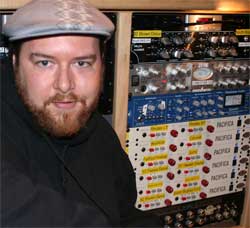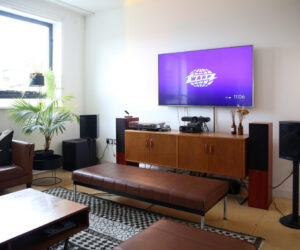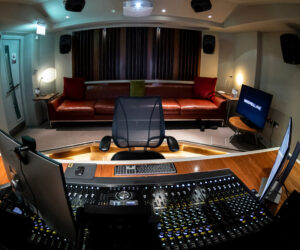Three-time Grammy Award-winning group The Black Eyed Peas recently made history by holding the number one spot on the Billboard Hot 100 chart for a staggering 26 consecutive weeks.
The two songs responsible for the reign—“Boom Boom Pow” followed by “I Gotta Feeling”—both came from Black Eyed Peas’ new record, “The END” (Energy Never Dies), which was tracked by Padraic “Padlock” Kerin and tracked/mixed by Dylan “3-D” Dresdow.
Dresdow, who owns Paper V.U. in North Hollywood, has worked with the group on four albums. He is quick to mention that he is an avid fan of A-Designs Audio. Among his collection are the Pacifica, P1, REDDI, HM2EQ HAMMER, MP-2 and several EM Series, plus a BAC-500 and Blast Pad Filter from sibling company Pete’s Place Audio, all of which were used during the mixing of “The END”.
“Most of “The END” was recorded and mixed at Record Plant, but I took some of my studio gear with me, as well as brought some sessions back to Paper V.U. to work on as well,” says Dresdow.
“One of the things that was interesting about this record was that there was a lot of synth stuff, especially synth bass. Although most people consider synths to be an afterthought—like adding a pad on a bridge—we were treating them as foreground instruments that were driving a lot of the record’s emotion, so we took their sound very seriously.
“The A-Designs Pacifica mic pre, which is based on a Quad Eight design, was one of the tools that really helped us craft our synth sounds. We frequently ran will.i.am and Keith Harris’ synth outputs through the direct injects on the front panel.
“I find that the Pacifica really brings out a lot of detail on the top end, so, by engaging the pads, it adds a nice tinge of darkness, which can be a really cool thing. I know a lot of engineers who work with the pads in almost all the time because they like the extra depth that they get out of the low end with it.”
When using a Moog Little Phatty for synth bass, Dresdow turned to the A-Designs REDDI direct inject box. “The REDDI really lends an extra dimension to bass instruments. When I pair it with the Little Phatty, it seems like I get this extra octave of low-end musical range out of the signal chain.
“I also find that I don’t have to EQ or compress things as often whenever I’m using the REDDI.”
According to Dresdow, another tool that played a big part on the new album was the HM2EQ HAMMER, which was used extensively for background vocals.
“The HAMMER is a magic EQ; in fact, I struggle to find things that it doesn’t sound good on,” he laughs. “I basically engaged the low cut switches on the unit, then boosted three frequency areas: 300Hz for extra body, 1.2kHz to add some presence and separation from the guitars, and 15kHz for top end sparkle.
“The resulting sound was a home run. The HAMMER is very versatile and I can hardly wait to get my hands on the new NAIL compressor when it comes out.”
Several 500 Series modules were also brought out for various sessions, including a P-1—based on the Pacifica and used on synth bass—and EM-PEQ on kick.
“The EM-PEQ is very reminiscent of the classic Pultec EQP1, but seeing that this version is solid-state, it doesn’t smear the audio quite as much. So you get this really nice roundness on your kick drum without messing with the detail of the top end and midrange.”
The BAC-500, another 500 Series module from sibling company Pete’s Place Audio, came into play on lead vocals during the mixdown process. “The BAC-500 is a very smooth compressor, and I almost always activate its distortion button, which helps things peek their head out a little bit more within a mix.”
When it became apparent that Dresdow would be recording a fair number of vocal overdubs for “The END”, A-Designs/Pete’s Place’s Peter Montessi asked him to try out the new Blast Pad filter screen.
“I didn’t really want to put it up at first, but I did and was stunned,” he confides. “It sounded incredibly better than the standard pop filter we were using.
“I even took the Blast Pad at one point and ‘motorboated’ into it, putting my hand behind it, and I couldn’t feel a thing! It was totally dispersing the airflow out the vents around the circumference without attenuating the sound in any way.
“Using the Blast Pad, we were able to get much more of the natural proximity effect out of our microphone without having to worry about extreme plosives that would otherwise cause the compressor to kick in a lot harder than we’d like. Bottom line is that it sounds amazing and is by far the best vocal filter out there.”
Dresdow sums his experience up on the project by adding, “The Black Eyed Peas are a very talented group. Not only have they sold millions and millions of records, but they also really know what they’re doing. When you’re working with competent people who know their craft and are experienced, you know that you’re going to get a good sound out of whatever gear you have on hand.
But when you have A-Designs and Pete’s Place gear on top of that, it just makes the whole process so much easier. The talent was awesome, the equipment was top-notch, and everything simply fell into place.”




















